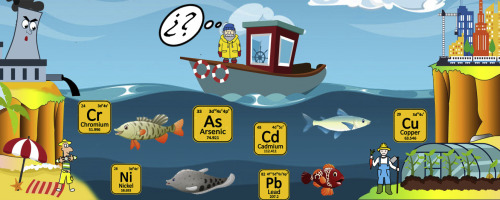For a considerable time, oceans and seas have been considered a means with a practically unlimited capacity to accumulate pollutants, with no immediate harmful effects for the marine environment or human health. However, we now realize that this is not true. The general public is aware of the harmful potential of some trace elements, commonly known as heavy metals (HMs) and metalloids (Alahabadi and Malvandi, 2018). These potentially toxic elements (PTE) may enter the environment through human activities, like mining and smelting processes (Gutiérrez et al., 2016; Kaitantzian et al., 2013; Odumo et al., 2014), or from fossil combustion (Kelepertzis and Argyraki, 2015; Rodríguez Martín et al., 2013a, Rodríguez Martín et al., 2014). In any case, human activities have substantially raised HMs concentration levels in recent decades (Rodríguez Martín et al., 2015). The pollutants are able to be bioconcentrated in the fish, even at very low concentrations, and most specifically in the liver. In fact the liver has been proposed as a biomarker of HM pollution (Ardeshir et al., 2017). Moreover, muscle is an edible part of fish and the part to which legislation refers. To evaluate the risk posed by metal bioaccumulation and biomagnification, more than monitoring only PTE levels in sediment or water samples must be accomplished to generate sufficient information (Jiang et al., 2018). Hence testing aquatic organisms like fish when monitoring marine pollution is very useful as they accumulate contaminants by direct absorption from water, and indirectly through food chains (Łuczyńska et al., 2018). In addition, given the long life span of some fish species, detecting the long-term effects of PTE on aquatic ecosystems is possible (Jiang et al., 2018). PTE can bioaccumulate in vital organs of fish, such as liver, kidneys and gills, several hundred times higher than can be detected in the surrounding environment (Chua et al., 2018). Bioaccumulation of PTE in fish tissues can be affected by factors like feeding habits, age, gender, genetic tendencies, and different swimming behaviors of fish species (Anandkumar et al., 2018). The consideration of Mediterranean Sea pollution is associated with semi-enclosed sea intensification of contamination effects (Aston and Fowler, 1985). The origin of PTE on the Almería coastline is related with various sources of pollution, of which the following stand out: atmospheric deposition associated with emissions released to the atmosphere, like Cu related with the local cement-making industry, As, Cd and Ni deriving from energy production, or Pb and Zn related with the area’s metal industry. Spillages of mainly Pb and As in Almería Bay waters is also a major source of pollution, and are associated with abusive fertilizer use in the greenhouse crops located all along the Almería coastline (Kelepertzis, 2014; Rodríguez Martín et al., 2013b). There are also spillages of wastewater into the bay, which considerably contribute Cd and Cu (Casadevall et al., 2016). Coastal ecosystems are also conditioned by a growing anthropogenic impact.
Eating fish is a recognized healthy habit that forms part of the Mediterranean diet, but can also be the main way by which PTE enter humans (www.who.int). The health benefits that fish intake can imply for people lie in the proteins, minerals and vitamins they contain, as well as their unsaturated essential fatty acid (UFAs) contents, such as omega-3 UFAs, including eicosapentaenoic acid (EPA) and docosahexaenoic acid (DHA). The Mediterranean Sea has been exploited since ancient times, and currently supplies fish to >480 million people (EEA, 2015). Spain is the third ranked country in the world for eating fish. Fish accumulate PTE from the sea, which depends not only on fish species, but also on environmental factors, and on the concentration levels and chemical forms in which elements are present (Perugini et al., 2014). Red mullet (Mullus surmuletus), European hake (Merluccius merluccius), bullet tuna (Auxis rochei) and Pacific Chub Mackerel (Scomber japonicus) are well-known and widely exploited species in the Mediterranean basin, and feature among the highly commercialized species on the Almería Fish Market, where Scomber japonicus is the second most caught species (2015–2017, IDAPES). Monitoring metal concentrations in different commercial fish is, therefore, important to ensure compliance with food safety regulations and consequent consumer protection (Bosch et al., 2016). Recent studies have shown that the concentration levels of HMs in fish in the Mediterranean Sea not only vary according to species, but are also strongly influenced by the area where fish are caught (Copat et al., 2018; Cresson et al., 2015; Ouali et al., 2018).
This study aimed to explore the potential toxicity risk of PTE in the four most consumed species on the Andalusian coast (S Spain) to: 1) determine the concentration levels of As, Cd, Cr, Cu, Ni and Pb contents in liver and muscle tissues; 2) study the relationship linking trace element contents and fish biometric composition; 3) evaluate the risk for the local population of developing health problems and diseases from eating these fish through Target Hazard Quotient (THQ) indices.

